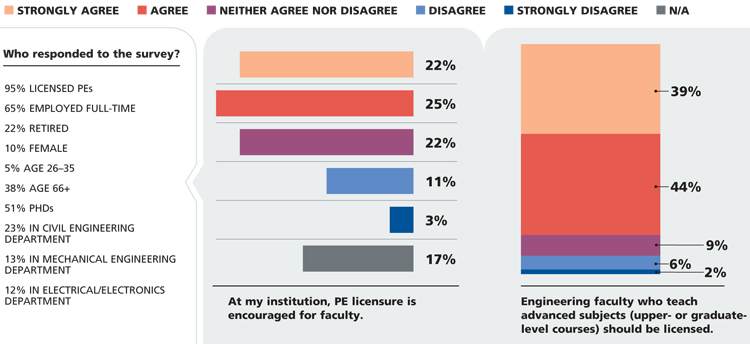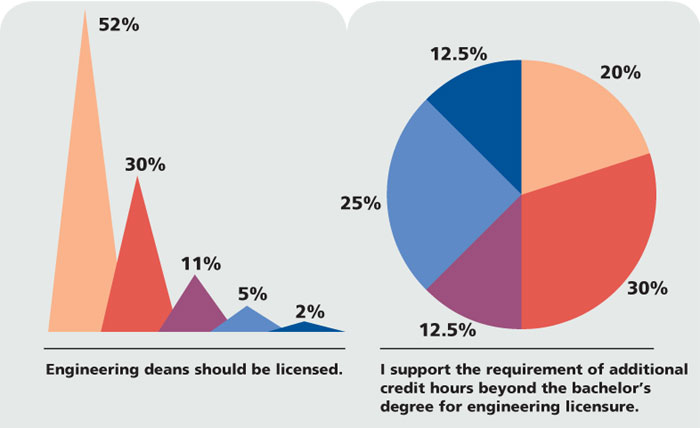December 2014
COMMUNITIES: EDUCATION
Survey: PE License Crucial in Academia, But Not Always Encouraged
Half of respondents are neutral or disagree with need for education beyond bachelor’s degree for licensure.
Members of NSPE’s Professional Engineers in Higher Education largely believe engineering deans and engineering faculty members teaching advanced subjects should be licensed PEs, but less than half believe licensure is encouraged at their institution.
Close to 80 PEHE members responded to PE magazine’s survey at the end of September, sharing their perspectives on topics such as licensure in academia, student preparation and support, and engineering department diversity. PE contacted a sampling after the survey to learn more.
Faculty Licensure
The majority of respondents believe that the image and stature of licensed engineers in education is positive. Almost two-thirds agreed or strongly agreed with this statement. However, less than half (47%) report that PE licensure is encouraged for faculty at their institution. Michael Keefe, P.E., associate chairman for undergraduate education at the University of Delaware, explains that licensure is not discouraged but certainly not encouraged at his school. As at many institutions, most engineering faculty at UD are not licensed.
Keefe adds that the primary goal of engineering faculty at the university is research, and licensure doesn’t play into appointments, promotion, and tenure as research does. “It wouldn’t make sense to [require] licensure” at the school, he says, disagreeing that engineering faculty who teach upper-level courses and deans should hold a PE.
That was the minority view, however. Eighty-three percent of survey takers strongly agreed or agreed that those faculty should be licensed. The same percentage also believe in licensure for engineering deans. “If all you’ve ever done is teach engineering, you lack a critical part of what students need to learn,” says Deni Adkins, P.E., engineering technician instructor at Northeast Alabama Community College. “You can only duplicate what you are.”
Despite strong feelings about licensure, the majority of respondents think that engineering faculty should pursue the traditional path to the PE. Fifty-eight percent of PEHE members disagreed or strongly disagreed that the PE and FE exam should be waived for faculty of ABET-accredited engineering programs who have earned engineering doctoral degrees.
Says Scott Sabol, P.E., professor in the architectural and building engineering technology department at Vermont Technical College, “a Ph.D. does not equate to sound, competent design ability ensuring public safety” or understanding how engineering fits into society, culture, and the economy.
Even more respondents were against the waiving of the experience requirement for faculty pursuing licensure (67%). “I don’t think there’s any amount of education that can replace experience in an actual consulting or manufacturing situation,” says Adkins.
As Sabol puts it, “I like someone to have learned [the responsibility of protecting the public safety] before they go stamping drawings.” He adds, “That’s not to say there aren’t people who can successfully be proficient without the experience. I just don’t like the odds.”
Some agree with a partial change of requirements for faculty, such as waiving the FE exam or substituting a Ph.D. degree for one year’s experience. Donald Andersen, P.E., who taught civil engineering at North Dakota State University, advocates waving the FE exam. “If they’ve gotten that far in life…you presume they know the basics,” he says.
He also believes that research can be substituted for design experience, pointing out that a lot of faculty have international backgrounds, and it is a hurdle for them to earn the required experience. “If you are doing research, you are keeping up in the field,” says Andersen. In addition, university requirements for publishing and research make it difficult to focus on field experience, he says.
But others take a harder line. David Rockstraw, P.E., New Mexico State University academic department head and chemical engineering professor, wants the same rigorous standards of exams and experience for everyone. The PEHE executive board member says he sees an effort by some groups to try to short circuit that process to license more faculty. But he “would … put an asterisk next to a PE license that follows a different path than others.”
The Student Experience
PEHE members were almost evenly split about the weight of student loans. While 38% strongly agreed or agreed that US students can earn an engineering degree without taking on a heavy debt load, 37% strongly disagreed or disagreed. “Nationwide, that average debt for students keeps rising,” says Keefe. “It’s not a good thing.”
More agreed that community colleges and technical institutes do enough to encourage and support students in transferring to four-year institutions than did not (44% versus 21%), but 35% neither agreed nor disagreed. Some indicated that they did not have enough information or knowledge to answer. Similarly, more agreed that students who transfer from community colleges to four-year institutions are overall academically prepared to succeed than disagreed (42% versus 22%), but again 35% neither agreed nor disagreed.
Sixty-nine percent of PEHE members said that their institutions have programs aimed at retaining engineering students and graduating them in a timely manner. However, a little less than a third could report that the programs have had positive results. Almost half did not know whether they had or not.
Overall, almost two-thirds of respondents think their institutions are doing a good job preparing engineering students in soft skill areas (communication skills, presentation skills, leadership, teamwork, and so forth).
PEHE members’ answers upheld trends of increasing engineering enrollment; almost two-thirds reported growing numbers of engineering students at their institutions over the last three years.
Hot Topics
The PEHE survey asked whether additional credit hours beyond the bachelor’s degree should be required for engineering licensure (i.e., B+30 and/or a master’s degree from an ABET-accredited program). More were in agreement (50%) than not (37.5%).
Mike Whitcomb, P.E., energy manager for a Maryland community college who has taught in the past, strongly agreed, saying that a stint as a practicing EIT followed by a master’s degree was a useful path and provided some “a-ha moments.”
But Adkins, is not sure that her master’s would have helped her pass the PE exam. “If you want to raise the bar then raise the bar” by putting additional knowledge in the tests, she says. “Don’t tack on education requirements that a lot of perfectly competent engineers who are married or have children aren’t going to be able to [fulfill].”
The survey also explored diversity in engineering departments. In 84% of respondents’ departments, at least one faculty member is a woman. However, less than half (40%) agreed that current efforts to encourage women to pursue engineering doctorates, and to support them on that path, are sufficient. Twenty-five percent disagreed, with the remainder neither agreeing nor disagreeing.
Reported minority representation was lower: 67% said their engineering department had at least one faculty member who was an underrepresented minority. Again, less than half (43%) agreed that current efforts to encourage underrepresented minorities to pursue engineering doctorates, and to support them on that path, are sufficient. Twenty-five percent disagreed, with the remainder neither agreeing nor disagreeing.




